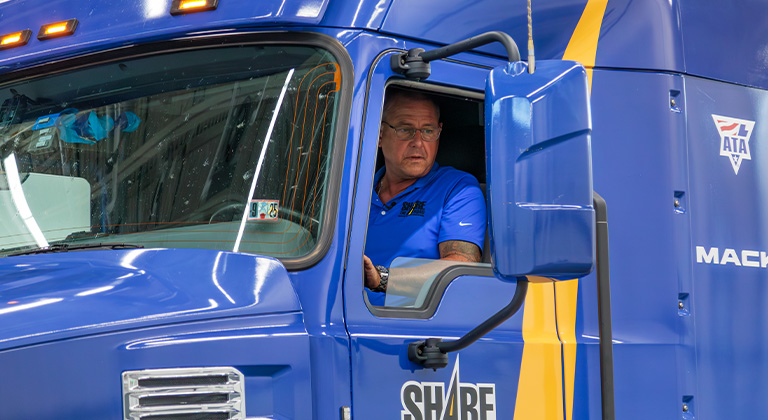How to improve the hiring and retention of safe, qualified drivers
Insights for trucking company owners navigating recruitment challenges
By Tom Kintz – Senior Safety Services Consultant, Sentry Insurance
For trucking companies, hiring safe, qualified drivers isn’t just a priority—it’s become a daily challenge. For carriers I work with, it seems like the bottom 10% of their driver pool turns over constantly. It’s a cycle that leads to higher costs, lower productivity, and increased risk on the road.
At Sentry, we understand how hard it is to recruit quality drivers. With the proper approach, tools, and mindset, you can build a reliable team.
What are the true costs of poor driver hiring practices?
When one of your drivers is the cause of an incident, your company doesn’t just face the cost of repairs or insurance claims—you may also be liable for negligent entrustment. That means if you assign duties to a driver without exercising proper care—including, but not limited to, properly conducting background checks—you, as the business owner, could be held responsible for any harm caused.
Hiring the wrong driver can also lead to:
Vehicle downtime and recovery costs
Damage to customer relationships and delivery schedules
Legal exposure if a crash occurs
Higher insurance premiums over time
To help reduce these risks, take a proactive and thorough approach to screening and vetting every driver—starting before they ever get behind the wheel for your business.
Clearly define the role in your job description
Your first opportunity to get the attention of quality drivers—and weed out the ones you don’t want—is with your job description. Be transparent when describing the job. Include details such as:
Salary (e.g., pay by hour, pay by percentage of loads, pay by cents per mile)
Hours expected
Driving schedule (e.g., five days on, five days off)
Driving routes (e.g., long haul vs. local)
Responsibilities (e.g., solely driving vs. loading/unloading, too)
Physical requirements
Customize the list based on your operations and the type of driver you’re looking for at the time of hiring.
Set stiff hiring standards
The Federal Motor Carrier Safety Administration (FMCSA) outlines minimum qualifications. Commercial drivers must:
Be at least 21 years old
Pass a DOT physical
Speak and read English well enough to interact with the public, understand highway traffic signs and signals, respond to official questions, and make legible entries on reports and records
Pass a road test or equivalent
Complete an application for employment
But in today’s environment, meeting the minimum compliance requirements isn’t enough. Many trucking operations now implement stricter guidelines to better protect their operations, such as:
At least three years of verifiable commercial driving experience
No more than one at-fault crash in the past three years
Zero DUI or drug violations within a three-year period
Fewer than four moving violations over the same time frame
These higher benchmarks give you more confidence that the driver you’re hiring is not only compliant—but safer, more dependable, and less likely to leave your business exposed to liability.
Run background checks—and don’t skip the details
I like to tell customers I work with, “Don’t be penny-wise and pound-foolish.” For $25 or $30, you can run a solid background check that might save you thousands—or more—down the line. Take advantage of available pre-employment screening programs.
Using my 47 years of experience in this industry, I always emphasize the importance of knowing exactly who you’re hiring. Skipping proper criminal screenings can leave your business vulnerable to costly, avoidable issues. A thorough background check should include:
Employment history verification
Criminal record screening
License validation
Drug and alcohol violations check through the FMCSA Clearinghouse
When establishing a background check program, always consult with your human resources, safety, and legal professionals to ensure the program is established for your particular circumstances and complies with applicable law. At Sentry, we offer access to vetted screening resources like InCheck, an employment screening service that helps you evaluate applicants based on your organization’s requirements.
Make motor vehicle records (MVRs) a standard part of your hiring process
MVRs can be one of your most telling resources in evaluating driver behavior. They provide insight into patterns that may not be obvious from an interview or application alone. Some red flags to watch for in the report include:
Excessive speeding (15+ mph above the limit)
DUI or drug-related violations
License suspensions or revocations
Hit-and-run or reckless driving charges
Don’t forget to look beyond the individual infractions. Are there employment gaps or frequent job changes? That churn may be a sign of deeper performance concerns. At Sentry, we help our customers interpret these reports to build a more complete driver profile.
Also keep in mind the data that appears on an MVR may not be up to date when you’re reviewing them. There are services available to alert you when a driver’s MVR changes. Consult your legal, human resources, and safety professionals for the proper way to conduct and use MVR checks and records.
If you have further questions about your driver candidate’s history, ask them during the interview process. Get answers to the tough questions now so you don’t have possible headaches later.
Work with your insurance company to support your safety goals
Many Sentry trucking customers rely on our Loss Control team for support beyond insurance. For instance, our team can help you:
Create and maintain driver qualification files
Provide safety training tailored to your operation
Stay compliant with FMCSA recordkeeping and reporting requirements
Use tools like InCheck to monitor ongoing driver eligibility
When you work with your insurance provider or groups like the American Trucking Associations, you’re not navigating these challenges alone. Take advantage of the experience and industry knowledge to help you.
Driver retention starts at the hiring stage
The hiring process isn’t just about screening out the wrong candidates—it’s also about keeping the quality ones. When you invest in your drivers from the start, they’re more likely to stay.
Stay engaged with your drivers. Communicate with them often and consistently. Set clear expectations and offer training that helps drivers feel confident and capable in their role. Depending on your operations, you may want to reward your drivers with certificates, safety bonuses, or tokens of appreciation. Consult with your human resources, safety, and legal professionals before implementing any rewards program to ensure it meets your particular circumstances and complies with applicable law.
Dedicate time and attention to your driver hiring process
While your drivers are ultimately responsible for keeping themselves safe on the road, it’s up to you to hire and train responsible drivers.
As a company, emphasize the behaviors you value in your drivers, and work with them to foster open communication and a positive working environment.
This document is made available by Sentry Insurance Company and its subsidiaries and affiliates (collectively “Sentry”) with the understanding that Sentry is not engaged in the practice of law, nor is it rendering legal advice. The information contained in this document is of a general nature and is not intended to address the circumstances of any particular individual or entity. Legal obligations may vary by state and locality. No one should act on the information contained in this document without legal advice from competent and licensed local professionals. THE INFORMATION CONTAINED IN THIS DOCUMENT IS DISTRIBUTED BY SENTRY “AS-IS,” WITHOUT ANY WARRANTIES. SENTRY WILL HAVE NO LIABILITY TO ANY PERSON OR ENTITY WITH RESPECT TO ANY LOSSES OR DAMAGES CAUSED, OR ALLEGED TO HAVE BEEN CAUSED, DIRECTLY OR INDIRECTLY BY THIS DOCUMENT, REGARDLESS OF WHETHER SUCH CLAIM IS BASED ON CONTRACT, WARRANTY, TORT (INCLUDING NEGLIGENCE AND FOR PROPERTY DAMAGE AND DEATH), OR OTHER GROUNDS.
Property and casualty coverages are underwritten, and safety services are provided, by a member of the Sentry Insurance Group, Stevens Point, WI. For a complete listing of companies, visit sentry.com. Policies, coverages, benefits, and discounts are not available in all states. See policy for complete coverage details.
Working together to advocate for the trucking industry
As a Corporate Partner of the American Trucking Associations, we work together to help support carriers of all sizes in the U.S.

About Tom
Tom Kintz is a Senior Safety Services Consultant at Sentry Insurance.
Related resources
Specialized trucking resources
Discover a wealth of resources at your fingertips, including essential tools, insightful articles, and practical guides on insurance coverage, safety, and retirement planning.
Motor truck cargo insurance
Learn how this coverage offers protection for your business against losses due to cargo destruction, theft, and more.
Other ATA articles
Driving change: Our latest legislative efforts in trucking reform
From fighting predatory towing to pushing for federal action on staged accidents, we’re on the front lines of legal system abuse reform for the trucking industry. Check out the latest updates from our Government Affairs team.
Timely claims reporting helps protect your business
The trucking industry faces mounting challenges from rising insurance costs driven by legal system abuses and varying state negligence laws. Learn how prompt claims reporting can help protect you and your fleet.
Crash management for drivers
This guide outlines essential crash response steps for truck drivers and fleet owners, focusing on driver safety, minimizing downtime, and reducing liability. Knowing what to do if an accident occurs can help you reduce losses and maintain your reputation.




